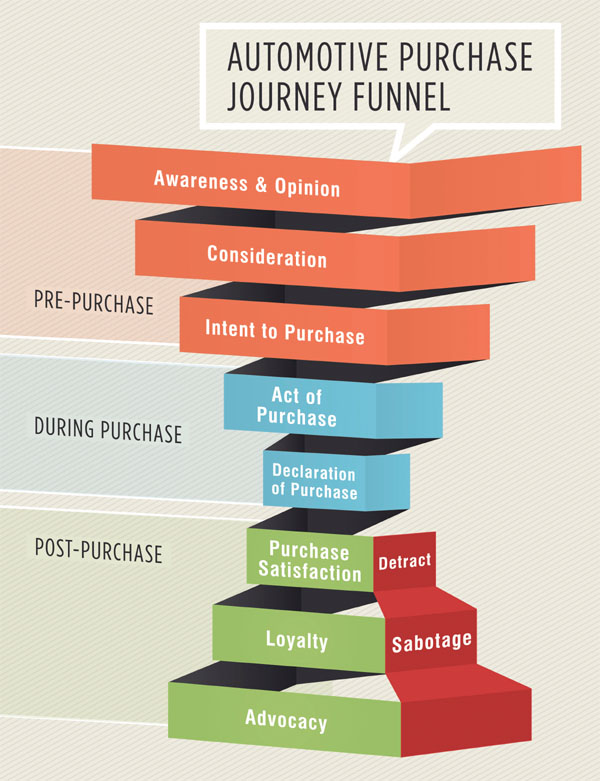Is Social Media Changing Car Buying Decisions?
People in the U.S. talk about their auto purchases 30,000 times a day on social media, most frequently during the consideration phase of buying a car, according to a new study commissioned by Starcom MediaVest Group and led by Big Fuel.
The study also found that if a car is not part of the social conversation during consideration phase, it rarely gets purchased.
The research identified significant real-time marketing opportunities for auto makers, verifying that social media including check-ins and photo sharing have an overwhelming influence over consumer auto purchase decisions.
The result: social media has established a new Automotive Purchasing Model, consumer behaviors and opportunities critical to driving auto sales.
[ Also Read: “Agencies Need to be Intrepid Explorers” ]
Starcom MediaVest Group’s Big Fuel partnered with Mashwork on the study that used advanced social listening and conversation segmentation to analyze more than 10 million automotive conversations over a 12-month period.
Data was collected from social media platforms including Twitter, public Facebook posts, blogs, forums, YouTube and more. The results of the study were released Thursday, Feb. 21.
[ Also Read: Is Online Ad Market Gaining Maturity? ]
“These findings identify opportunities for marketers to engage at pivotal times in the purchase funnel,” says Laura Desmond, global CEO, Starcom MediaVest Group.
“It gives us the insights needed to connect with real-time, contextually relevant content that can positively drive engagement and influence at various purchasing stages. From customer service and offering timely added-value benefits, to optimizing scheduling media placements for when and where the conversation is taking place, the findings identified clear implications and opportunities for marketers engaging through social.”
[ Also Read: Seven Tricks Digital Agencies Use to Cheat You ]
Study findings and marketer implications include:
- Social media has dramatically altered the auto purchase journey. The journey now includes an expanded “purchase” phase that reflects the rise of social check-ins and status updates via mobile devices and a new “post purchase satisfaction and dissatisfaction” stage.
Implication: New messaging and brand experiences need to be created and specific brand ambassadors or customer service representatives dedicated to watch and respond to post purchase dissatisfaction.
[ Also Read: Why You Should Not Advertise on Facebook ]
- People in the U.S. talk about their auto purchases on average 30,000 times per day, 1,250 times per hour and 21 times per minute on social media. Twitter alone generated 184 million potential impressions per day.
Implication: Social data, including listening and measurement, should be used to amplify the impact of all marketing activity.
- Most conversation in new automotive purchase journey resides in “consideration” phase at 29%. Brands not included in this phase rarely make it to the final stage of purchase.
Implication: Marketers should adjust copy rotations and media placements accordingly to influence make and model decisions.
[ Also Read: Five Bitter Truths about Social Media ]
- “Declaration of purchase” represents 19% of total conversation. People show off their new cars to their social networks and express excitement in taking ownership. When declaring car purchases, new owners are 2.4 times more likely to attach a photo of their new car to add visual appeal to the excitement than to check-in or self-identify as at a dealership.
Implication: Focus on social direct marketing during the significant “declaration of purchase” phase. Opportunities to connect with other potential buyers in the area by offering relevant added-value benefits and amplifying the joy generated by the purchase.
[ Also Read: Top 20 Digital Brand Campaigns of 2012 ]
- “Post purchase satisfaction” conversation occurs three times more often than “post purchase dissatisfaction” conversation. Dissatisfaction conversation tends to be more passionate with higher levels of emotion positive conversation.
Implication: By continuing the relationship and “post purchase satisfaction” conversations with buyers, auto companies can potentially lead consumers through to their next purchase journey. The balance of emotional statements suggests the relationship gets stronger and can be optimized via extended conversation and relationship marketing.
[ Also Read: Do Not Spend Even a Single Penny on SEO ]
- Social, in addition to search, increasingly becoming the “go to” source for personalized information and real time reviews for in-market car shoppers. With 12 times more educators and enthusiasts than advice seekers within social, car shoppers are flocking to social to seek advice from experts more knowledgeable than themselves.
Implication: In 2012, search had 10 times more ad spend versus social platforms, according to Zenith Optimedia Ad Spend Forecasts. This New Automotive Purchase Journey and social’s ability to provide recommendations at scale, requires a reallocation of media mix, shifting increased auto budget from analogue media and into digital, with a significant focus on the connection between search and social and the provision of real-time expert opinion and facilitation of conversations about brands that last throughout the new purchase journey.
“Social media is changing the automotive purchase journey and there are new opportunities for marketers to connect in real-time where the conversations are taking place,” said Kate Sirkin, EVP, Global Research Director, Starcom MediaVest Group.












